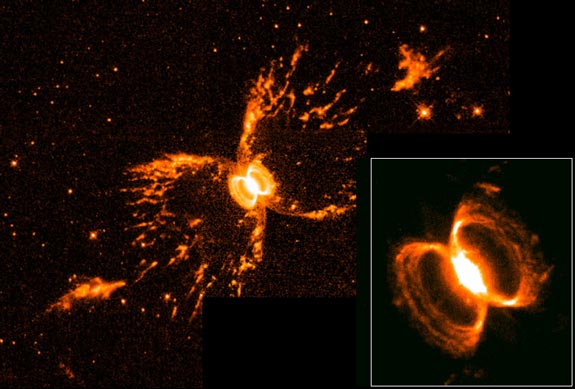
|
Credit & Copyright: R. Corradi
(Instituto de Astrofisica de Canarias) et al.,
NASA
Explanation:
The two stars at the center of this nebula are very different.
One is a
white dwarf star
with a mass similar to our Sun but with a radius as small as our Earth.
The other star is a
red giant, a star also with mass near our Sun but
with a radius so large it could fill the orbit of the Earth.
The strange symbiotic relationship between these two stars in the
He2-104 system has created a
planetary nebula shaped like an
hourglass within an
hourglass.
The
red giant star turns out to be a
Mira variable,
a pulsating star that is dumping mass into an
accretion disk surrounding the
white dwarf.
Astronomers speculate that when enough mass
falls onto the white dwarf, a
thermonuclear explosion occurs creating another
expanding hourglass-shaped nebula.
The
above photograph was taken with the
WFPC2 instrument onboard the
Hubble Space Telescope.
The hourglasses from the two most recent explosions
are visible with the last one highlighted in the inset.
|
January February March April May June July August September October November December |
| |||||||||||||||||||||||||||||||||||||||||||||||||||||||
NASA Web Site Statements, Warnings, and Disclaimers
NASA Official: Jay Norris. Specific rights apply.
A service of: LHEA at NASA / GSFC
& Michigan Tech. U.
Based on Astronomy Picture
Of the Day
Publications with keywords: symbiotic star - white dwarf - star
Publications with words: symbiotic star - white dwarf - star
See also:
